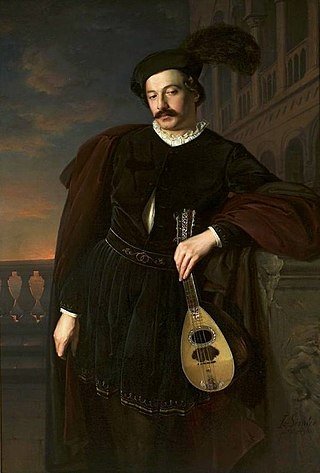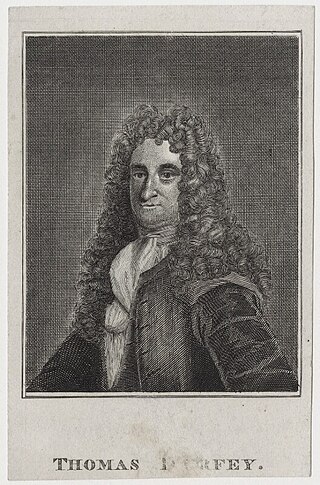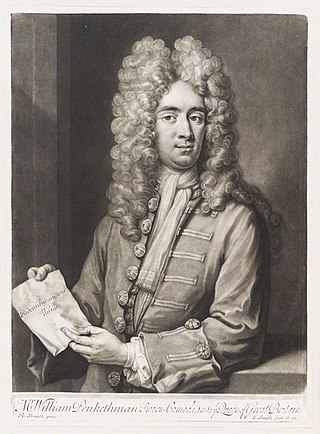Related Research Articles

Don Quixote is a Spanish epic novel by Miguel de Cervantes. It was originally published in two parts, in 1605 and 1615. Considered a founding work of Western literature, it is often labelled as the first modern novel and one of the greatest works ever written. Don Quixote is also one of the most-translated books in the world and one of the best-selling novels of all time.

Henry Purcell was an English composer of Baroque music.
John Eccles was an English composer.
Peter Anthony Motteux was a French-born English author, playwright, and translator. Motteux was a significant figure in the evolution of English journalism in his era, as the publisher and editor of The Gentleman's Journal, "the first English magazine," from 1692 to 1694.
This article contains information about the literary events and publications of 1700.
This article contains information about the literary events and publications of 1696.
This article contains information about the literary events and publications of 1694.

Don Juan, also known as Don Giovanni (Italian), is a legendary, fictional Spanish libertine who devotes his life to seducing women.
The History of Cardenio, often referred to as simply Cardenio, is a lost play, known to have been performed by the King's Men, a London theatre company, in 1613. The play is attributed to William Shakespeare and John Fletcher in a Stationers' Register entry of 1653. The content of the play is not known, but it was likely to have been based on an episode in Miguel de Cervantes's Don Quixote involving the character Cardenio, a young man who has been driven mad and lives in the Sierra Morena. Thomas Shelton's translation of the First Part of Don Quixote was published in 1612 and would thus have been available to the presumed authors of the play.
The history of opera in the English language commences in the 17th century.

Thomas d'Urfey was an English writer and playwright. He wrote plays, songs, jokes, and poems. He was an important innovator and contributor in the evolution of the ballad opera.
Thomas Shelton was a translator of Don Quixote. Shelton's translation of the first part of the novel into English was published in London in 1612. It was the first translation into any language.
Don Quixote, fully El ingenioso hidalgo Don Quijote de la Mancha, is a classic novel by Miguel de Cervantes Saavedra, originally published in two parts, in 1605 and 1615.

Baroque music of the British Isles bridged the gap between the early music of the Medieval and Renaissance periods and the development of fully fledged and formalised orchestral classical music in the second half of the eighteenth century. It was characterised by more elaborate musical ornamentation, changes in musical notation, new instrumental playing techniques and the rise of new genres such as opera. Although the term Baroque is conventionally used for European music from about 1600, its full effects were not felt in Britain until after 1660, delayed by native trends and developments in music, religious and cultural differences from many European countries and the disruption to court music caused by the Wars of the Three Kingdoms and Interregnum. Under the restored Stuart monarchy the court became once again a centre of musical patronage, but royal interest in music tended to be less significant as the seventeenth century progressed, to be revived again under the House of Hanover. The Baroque era in British music can be seen as one of an interaction of national and international trends, sometimes absorbing continental fashions and practices and sometimes attempting, as in the creation of ballad opera, to produce an indigenous tradition. However, arguably the most significant British composer of the era, George Frideric Handel, was a naturalised German, who helped integrate British and continental music and define the future of music in the United Kingdom.

Cave Underhill (1634–1710?) was an English actor in comedy roles.

The Female Quixote; or, The Adventures of Arabella is a novel by Scottish writer Charlotte Lennox imitating and parodying the ideas of Miguel de Cervantes' Don Quixote. Published in 1752, two years after she wrote her first novel, The Life of Harriot Stuart, it was her best-known and most-celebrated work. It was approved by both Henry Fielding and Samuel Richardson, applauded by Samuel Johnson, and used as a model by Jane Austen for Northanger Abbey. It has been called a burlesque, "satirical harlequinade", and a depiction of the real power of females. While some dismissed its protagonist Arabella as a coquette who simply used romance as a tool, Scott Paul Gordon said that she "exercises immense power without any consciousness of doing so". Norma Clarke has ranked it with Clarissa, Tom Jones and Roderick Random as one of the "defining texts in the development of the novel in the eighteenth century".

"Rinconete y Cortadillo" is one of the twelve short stories included in Novelas Ejemplares, by Spanish writer Miguel de Cervantes. It describes the comical adventures of two petty criminals as they travel to Seville and are then taken in by the city's thieves' guild. Seville at the time was a rich city with marked social contrasts, being the entrepôt of Spain and the new world of the Americas.

William Pinkethman was an English comic actor, a low comedian with a droll style, and theatre manager. He was considered an imitator of Anthony Leigh.
Harry Danks, (1912-2001) was a British violist and principal viola of the BBC Symphony Orchestra from 1946 to 1978. He was the founder and director of the London Consort of Viols.
References
- ↑ http://www.letrs.indiana.edu/cgi-bin/eprosed/eprosed-idx?coll=eprosed;idno=P2.0294%7C English Prose Drama: The Comical History of Don Quixote
- ↑ "Music in the Provinces: Bath". www.jstor.org. JSTOR 922789.
- 1 2 https://www.amazon.com/dp/B000000UL1%7C "Don Quixote: The Musical"
- ↑ "Don Quixote - The Musical". www.medieval.org.
- ↑ "Radio 3 Programmes - Drama on 3, Don Quixote, by Thomas D'Urfey". BBC. 2009-11-22. Retrieved 2010-07-26.
- ↑ http://www.radiodramareviews.com/id370.html%7C Don Quixote: The Musical